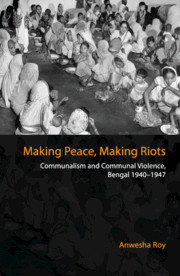Book contents
- Frontmatter
- Frontmatter
- Contents
- Maps and Figures
- Acknowledgements
- Abbreviations
- Glossary
- Introduction
- 1 The Dacca Riot, 1941
- 2 Famine 1943 – Towards a Hardening of Community Identities
- 3 From Community to Communal: The Bengal Secondary Education Bill and the Idea of Pakistan
- 4 The Great Calcutta Killing, August 1946
- 5 Noakhali Riots, October 1946
- 6 A Test of Faith: Gandhi in Noakhali and Calcutta 1946–47
- Concluding Remarks
- Appendix 1
- Appendix 2
- Appendix 3
- Appendix 4
- Bibliography
- Index
4 - The Great Calcutta Killing, August 1946
Published online by Cambridge University Press: 23 October 2018
- Frontmatter
- Frontmatter
- Contents
- Maps and Figures
- Acknowledgements
- Abbreviations
- Glossary
- Introduction
- 1 The Dacca Riot, 1941
- 2 Famine 1943 – Towards a Hardening of Community Identities
- 3 From Community to Communal: The Bengal Secondary Education Bill and the Idea of Pakistan
- 4 The Great Calcutta Killing, August 1946
- 5 Noakhali Riots, October 1946
- 6 A Test of Faith: Gandhi in Noakhali and Calcutta 1946–47
- Concluding Remarks
- Appendix 1
- Appendix 2
- Appendix 3
- Appendix 4
- Bibliography
- Index
Summary
One of the most astonishing experiences of the Calcutta riots, for me, was the morning of 16th August 1946. No doubt it will be said that it is so easy to be wise after the event, but I can honestly say that, if I ever felt tension in the city (that well-known communal barometer reading of this second city), it was then … There was a curious stillness in the air.
Extract from the Diary of Major L. A. LivermoreStarting with August 1946, India began to witness a wave of communal violence, particularly in Bihar, Punjab and Bengal. The Great Calcutta Killing constituted something like a holocaust, exceeding anything that the city of Calcutta has ever seen. It marked the beginning of what Suranjan Das has termed as the ‘Partition Riots’ of Bengal. This study concentrates more on the events of the riots, especially in terms of the rioters’ modes of participation, studying both violence and anti-communal peace efforts, and tries to explore their mutual dependence and relationship.
We have already seen in the previous chapter how the constitutional deadlock regarding the Wavell Plan and the non-acceptance of Pakistan by the Cabinet Mission had frustrated Jinnah to the point of eventually issuing the war cry of Direct Action. The Direct Action Day program mainly comprised of a public meeting at the Maidan, an open public ground in South-Central Calcutta. Muslim League supporters expected to draw a crowd of five lakhs. ‘For the minority Muslims of Calcutta, many coming from the overcrowded and squalid slums of the city's industrial wards, to physically occupy the city's most hallowed civic space, en masse, was a bold expression of corporate power.’ About a thousand Muslim National Guard volunteers were deployed to keep the crowd under control, and speeches were made by Chief Minister Suhrawardy, Sir Nazimuddin and other leading Muslims, all of whom reiterated the demand for Pakistan. Calling the Cabinet Mission a bluff, Suhrawardy pointed out that the Direct Action Day was the first step towards Muslim emancipation. Mills in Calcutta were closed down and all buses and trams came off the road. Life in the city was at a low ebb as the day was declared a holiday.
- Type
- Chapter
- Information
- Making Peace, Making RiotsCommunalism and Communal Violence, Bengal 1940–1947, pp. 148 - 183Publisher: Cambridge University PressPrint publication year: 2018



